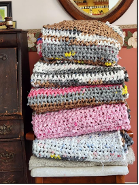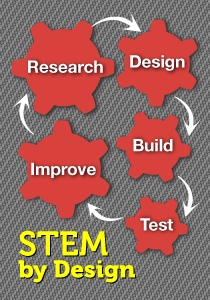A MiddleWeb Blog
 Back in the early months of the Covid pandemic, we published an article, Need a Real-World STEM Project? Try Plastics Pollution, by author, science educator and STEM curriculum developer Anne Jolly. Five years and tens of millions of metric tonnes later, the problem of mismanaged plastic waste has only worsened. We asked Anne to update her article and include some fresh perspective, data and lesson ideas.
Back in the early months of the Covid pandemic, we published an article, Need a Real-World STEM Project? Try Plastics Pollution, by author, science educator and STEM curriculum developer Anne Jolly. Five years and tens of millions of metric tonnes later, the problem of mismanaged plastic waste has only worsened. We asked Anne to update her article and include some fresh perspective, data and lesson ideas.
Picture this: A student in your class finishes a bottle of water, tosses it in the trash, and never thinks about it again. For them, the story ends there. But for you, as their teacher, that’s the perfect starting point for a STEM challenge.
Plastic may seem harmless, but that plastic bottle could stick around on Earth as many as 500 years! In fact, there’s no such thing as throwing plastic away. Ninety-nine percent (99%) of plastic products do not biodegrade. Instead, they pile up in landfills, find their way into rivers and oceans, and eventually break down into tiny pieces called microplastics that are found in soil, air, and even animals’ bodies. (Scientists are finding increasing amounts of microplastics in human lungs, bones, blood, and placentas.)
A Real-World STEM Challenge
Plastics first came into widespread use in everyday items after World War II. At first it seemed like a miracle material, and soon our whole world was full of products packaged in this strong, flexible, lightweight, and relatively inexpensive material. But here’s the flip side: plastic is made from fossil fuels – a nonrenewable resource. It contributes to climate change and does not biodegrade. And it has significant health impacts on living organisms.

Our world is experiencing a plastics crisis. Currently huge, island-sized masses of plastic are accumulating in the ocean. Right now at least five super-size plastic garbage patches are building up in the world’s oceans. The largest of these, the Great Pacific Garbage Patch (GPGP), is twice the size of Texas. These vast plastic garbage patches are more than piles of floating debris – they’re made up mostly of small particles the size of a grain of sand. Some are small enough for bacteria to ingest. They enter the ocean food chain and can interfere with the reproduction of fish and other species. For recent information on this, see Plastic Pollution in the Ocean – 2025 facts and Statistics.).

Plastic is both useful and provides health and environmental challenges. As such, plastic pollution is a perfect real-world issue for STEM learning. It’s complex, it matters worldwide, and your students can actively participate now in helping to tackle this escalating problem. Addressing this complicated issue will be increasingly important as they reach adulthood.
STEM Starters
Before beginning any challenge, your students need to understand the problem: How can we prevent this useful product from becoming an even greater worldwide (and local) problem? You might introduce them to the challenges of plastic with one or more of these short, engaging articles or videos:
• National Geographic – The Problem with Plastic Pollution
• TED Ed – What Really Happens to the Plastic You Throw Away
• National Science Foundation – What Are Microplastics?
STEM Project Ideas
Now your students are ready to practice problem-solving with a real and immediate purpose. Recycling, reusing, and reducing plastic use are three currently used approaches and can provide opportunities for students to apply science, math, engineering, and technology skills while developing problem-solving habits they’ll use for life. Let’s take a look at each of these three options:
►Recycling
Recycling plastic means collecting used plastic items, breaking them down, and processing the material so it can be made into new products instead of being thrown away. Okay, so what happens if they toss their plastic bottles into a special container called a recycling bin rather than a trash can? Here’s a surprising fact:
Recycling one plastic bottle saves enough energy to power a lightbulb for 3 hours! Wow. That can make a difference!
Do this:
• Ask students to estimate the number of plastic bottles they use each day.
• Each week?
• What about the number of plastic bottles their classmates use in a week?
• How much energy a week might students in the whole school save by recycling bottles?
Resource: This article, How Is Plastic Recycled: Step by Step, explains what happens to plastic they recycle.
 Try this detective challenge: Ask kids to look for the little triangle symbol with a number inside on their plastic items – usually on the bottom. That number tells them the type of plastic that makes up that item. Here’s a quick key . . .
Try this detective challenge: Ask kids to look for the little triangle symbol with a number inside on their plastic items – usually on the bottom. That number tells them the type of plastic that makes up that item. Here’s a quick key . . .
#1 PET – water bottles, soda bottles. Easy to recycle!
#2 HDPE – milk jugs, detergent bottles. Also easy to recycle.
#3 – #7 – Plastic products with these numbers are somewhat hard or very hard to recycle. These include pipes, food wrap, grocery bags, yogurt cups, straws, styrofoam, and mixed plastics.
Knowing those codes helps them be recycling detectives, spotting which plastics to recycle and which ones to reuse.
►Reuse
Students can find, practice, and invent innovative ways to reuse plastic. Reusing plastic is often confused with recycling. Reuse means finding ways to use a plastic item more than once – without throwing it away after its first use. If kids want to focus on reusing plastic, check out some of these articles:


Bed rolls made from plastic bags with the help of the Magnolia Garden Club in Warrior, AL.
30 Ways to Reuse Plastic. Use plastics to develop solutions that help people – such as collecting plastic bags and using them to make plastic bed rolls for those without shelter. (For detailed description of how to do this, see this video: How to Make a PLARN Bed Roll.).
STEAM Class. Reuse plastics to create art. In this way their STEM projects can involve art in an authentic manner that helps to solve a problem. This article may give students arts and craft ideas: 56 Best Plastic Bottle Craft Ideas for Kids. For additional ideas see 30 Recycled Crafts for Kids or simply use Google Images to search for “plastic art.”
►Reduce
Given our reliance on plastic, this may be our most difficult option. Some companies are currently making efforts to make plastic from plants and other biodegradable products, but they haven’t yet found a material or method as cheap and effective as using fossil fuels.
Here’s a STEM idea: your STEM students may want to create an eco-friendly plastic from plant materials. They could experiment with making a bioplastic by mixing starch, a plasticizer (like glycerin or vinegar), and water – then heating the mixture until it thickens into a plastic-like gel and molding this into a product. One class of STEM students I worked with experimented with making plastics and creating biodegradable hockey pucks.
 Suggest that students can also take responsible actions by reducing their own plastic use. Advise them to start small and choose one plastic item – perhaps plastic bottles, straws, grocery or lunch containers. They could reduce their use of this item and then add another.
Suggest that students can also take responsible actions by reducing their own plastic use. Advise them to start small and choose one plastic item – perhaps plastic bottles, straws, grocery or lunch containers. They could reduce their use of this item and then add another.
Students might also organize a recycling/reuse/reduce drive or an eco-club in their school, along with creating posters and videos showing how to limit plastic use. Raising awareness can also include letter campaigns questioning companies about their plastic choices (e.g., putting prescriptions in #5 bottles instead of #1 or #2.)
Your Leadership Matters!
Middle school is the perfect time for students to see themselves as problem solvers, inventors, and future engineers. Whatever approach students take on as a plastics challenge, avoid giving them solutions. Instead, turn it into a STEM project by letting them identify a specific problem to address and work together in small teams to develop and experiment with a solution for the problem. All teams do not need to work on the same solution – give them creative power – but they should approach the solution using a STEM process. This free, downloadable tool from the STEM By Design book website can prove useful in that regard.
And be sure to do this: The next time a student holds a plastic bottle, ask: “Will this sit in a landfill for centuries, or can you give it a new life?”
Extra Resources
MiddleWeb: Need a Real-World STEM Project? – check out my 2020 article for more classroom-tested ideas for plastics projects.
Plastic Pollution Curriculum and Activity Guide – ideas for K–12 students. Not all are STEM ideas, but some can be adapted.
Plastics Challenge – opportunities for middle school students to learn about and address challenges caused by plastic waste.
Anne Jolly’s bestselling book STEM by Design: Tools and Strategies to Help Students in Grades 4–8 Solve Real-World Problems (Routledge/Eye on Education, 2025) is now available in a Second Edition, with lots of new content and fresh teaching strategies. Also visit Anne’s book website, where you’ll find many free resources, including downloadable tools that support every aspect of designing a strong STEM program in your school.




